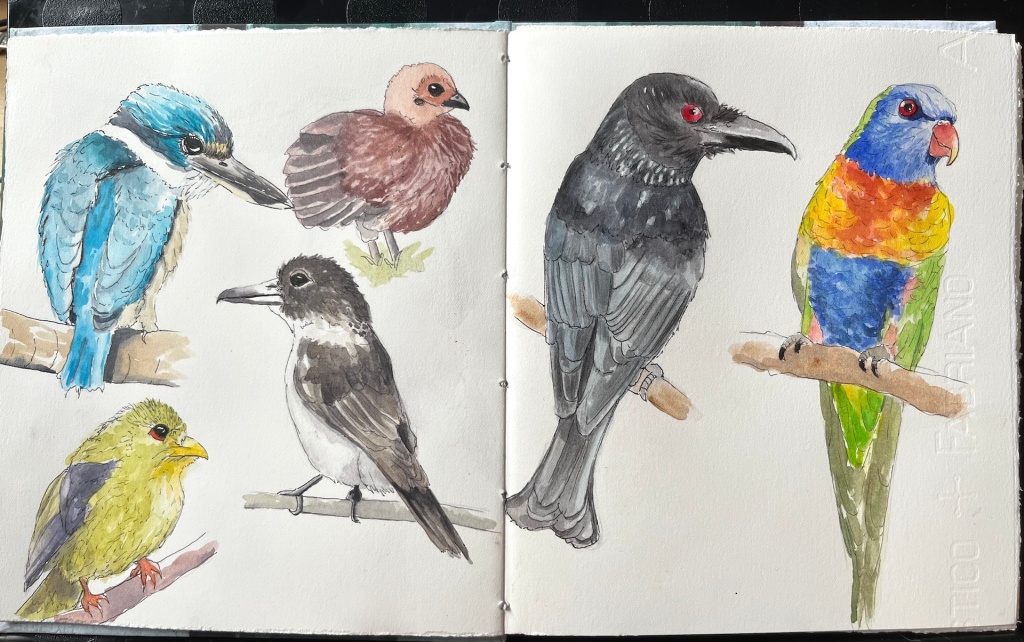
Australia is a land of birds. They are numerous and diverse, with almost half of them being found nowhere else on Earth. I could easily spend a year just painting and describing my own personal encounters with different birds, but I’ll keep it to a two page spread for brevity:
- Left page, top left. My daughter spotted a Sacred Kingfisher (left page, top left) sitting on a wire outside our window and noticed immediately it was different from our regular visitors. Though we have heard them calling sometimes, they are considered uncommon and usually don’t sit out in the open as this one did. We watched it for a few minutes before it flitted off in search of lunch. I’m not sure whether I was more chuffed at seeing a Sacred Kingfisher or at my daughter’s observation skills.
- Left page, top right. Last year, my dogs found a baby brush turkey, which had collapsed with heat stroke in our back yard. The dogs hadn’t harmed it – if anything my female pooch would have curled herself around it to protect it and my boy would have run away in fear – he’s that dog. We brought the fluffy, round, softball-sized baby inside and called a wildlife rescue organisation for advice. We were advised to give it drops of water, which my husband had already done, and leave it to cool down. The poor thing was quite weak and floppy and we really didn’t think it would survive. But we were assured they are very resilient, since they’re booted out of the next almost as soon as they’re hatched and have to feed and fend for themselves. “Just pop it back in your garden, somewhere with shade and away from any pets,” the woman said. Sure enough, the little ball began to rouse and quickly became quite keen to leave. We popped it outside under some bushes and left it alone. A few days later my husband saw a slightly fatter baby brush turkey where he’d deposited it.
- Left page, bottom right: Grey Butcher birds are common and usually not to be trifled with – an adult bird once gave me quite a nasty bite on my index finger while I was rescuing it from being tangled quite badly in the netting covering our fish pond. He didn’t know he was being rescued, and to this day probably still believes it was biting the finger that saved him, not the fingers themselves. More recently we had a fledgling butcher bird who roosted each night under the roof of our back veranda for awhile. If we came outside to let the dogs out he would squawk to let us know he was there and we would say hello and pretend his presence wasn’t a big deal. He felt safe, despite my two crazy dogs and our comings and goings. One night about five weeks later he didn’t show up. I figured he’d probably found his tribe and move in to a new place (I pity any creature that would willingly try to eat a butcher bird). About a month later my husband was mowing the lawn and a fully fledged butcher bird was following him around swooping up the insects and chattering to him, not at all afraid of him. Sometimes the little guy sits in a tree while we garden and chatters to us. Birds remember kindness. Or at least humans who don’t harass them.
- Left page, bottom left. The forests of New South Wales and southeast Queensland ring with the sound of the Bell Miner, or colloquially, bell birds. It is a family delight to wind down the windows while driving over the Border Ranges in order to listen to the constant pinging of these olive-coloured honeyeaters. The air in the mountains is almost always a number of degrees cooler and sweeter smelling and the sound of the birds only adds to the region’s mystique. Despite the fact Bell Miner’s live in large colonies, they aren’t seen often. Occasionally one will be seen flitting across the road, but I can count on one hand the number of times I’ve actually laid eyes on one.
- Right page, left illustration: A Spangled Drongo – so named for the white flecks around its collar – once flew in to my second story window and plummeted to the ground. When we got outside it was alive, but dazed and bleeding from the beak. We put it in a box thinking it would either recuperate there or die (which we honestly thought was the most likely). The idea really was to keep it away from my dogs and the terrible heat outside. About ten minutes later the bird erupted from the box, screaming blue murder and trying to find an exit from the house. My husband had to catch the bird in order to let it outside. It flew off in a great fury, yelling and complaining about its awful and terrifying experience.
- Right page, right. I could hear the rainbow lorikeets as I painted these. Right now, they have a babies, which are constantly begging for food with their small screechy voices. The parents chirp to each other as they pick at nectar-laden trees. It is a quintessential sound of southeast Queensland. A few years ago, one such lorikeet accidentally flew in through an open door in my home, spent a few confused minutes hanging off my curtains, and eventually allowed itself to be ushered back outside to its waiting partner. What a story s/he had to tell.
